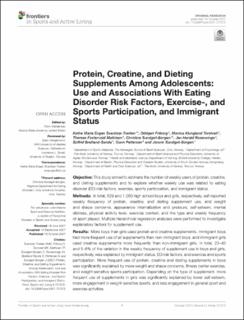| dc.contributor.author | Svantorp-Tveiten, Kethe Marie Engen | |
| dc.contributor.author | Friborg, Oddgeir | |
| dc.contributor.author | Torstveit, Monica Klungland | |
| dc.contributor.author | Mathisen, Therese Fostervold | |
| dc.contributor.author | Sundgot-Borgen, Christine | |
| dc.contributor.author | Bratland-Sanda, Solfrid | |
| dc.contributor.author | Pettersen, Gunn | |
| dc.contributor.author | Sundgot-Borgen, Jorunn | |
| dc.contributor.author | Rosenvinge, Jan Harald | |
| dc.date.accessioned | 2021-12-10T09:35:37Z | |
| dc.date.available | 2021-12-10T09:35:37Z | |
| dc.date.created | 2021-09-13T20:04:27Z | |
| dc.date.issued | 2021 | |
| dc.identifier.citation | Frontiers in Sports and Active Living. 2021, 3(2021), Artikkel 727372. | en_US |
| dc.identifier.issn | 2624-9367 | |
| dc.identifier.uri | https://hdl.handle.net/11250/2833725 | |
| dc.description | This is an open-access article distributed under the terms of the Creative Commons Attribution License (CC BY). The use, distribution or reproduction in other forums is permitted, provided the original author(s) and the copyright owner(s) are credited and that the original publication in this journal is cited, in accordance with accepted academic practice. No use, distribution or reproduction is permitted which does not comply with these terms. | en_US |
| dc.description.abstract | Objective: This study aimed to estimate the number of weekly users of protein, creatine, and dieting supplements and to explore whether weekly use was related to eating disorder (ED) risk factors, exercise, sports participation, and immigrant status.
Methods: In total, 629 and 1,060 high school boys and girls, respectively, self-reported weekly frequency of protein, creatine, and dieting supplement use, and weight and shape concerns, appearance internalization and pressure, self-esteem, mental distress, physical activity level, exercise context, and the type and weekly frequency of sport played. Multiple hierarchical regression analyses were performed to investigate explanatory factors for supplement use.
Results: More boys than girls used protein and creatine supplements. Immigrant boys had more frequent use of all supplements than non-immigrant boys, and immigrant girls used creatine supplements more frequently than non-immigrant girls. In total, 23–40 and 5–6% of the variation in the weekly frequency of supplement use in boys and girls, respectively, was explained by immigrant status, ED risk factors, and exercise and sports participation. More frequent use of protein, creatine and dieting supplements in boys was significantly explained by more weight and shape concerns, fitness center exercise, and weight-sensitive sports participation. Depending on the type of supplement, more frequent use of supplements in girls was significantly explained by lower self-esteem, more engagement in weight-sensitive sports, and less engagement in general sport and exercise activities.
Conclusion: Weekly supplement use was common and more frequent among boys than girls. The weekly use of protein, creatine, and dieting supplements was related to ED risk factors, exercise and sports participation, and immigrant status in boys but not in girls. | en_US |
| dc.language.iso | eng | en_US |
| dc.relation.uri | https://www.frontiersin.org/articles/10.3389/fspor.2021.727372/abstract | |
| dc.subject | adolescent | en_US |
| dc.subject | body image | en_US |
| dc.subject | dietary supplement | en_US |
| dc.subject | eating disorder | en_US |
| dc.subject | exercise | en_US |
| dc.subject | immigrant status | en_US |
| dc.subject | mental health | en_US |
| dc.subject | sport | en_US |
| dc.title | Protein, creatine, and dieting supplements among adolescents: Use and associations with eating disorder risk factors, exercise-, and sports participation, and immigrant status | en_US |
| dc.type | Peer reviewed | en_US |
| dc.type | Journal article | en_US |
| dc.description.version | publishedVersion | en_US |
| dc.rights.holder | © 2021 Svantorp-Tveiten, Friborg, Torstveit, Mathisen, Sundgot-Borgen, Rosenvinge, Bratland-Sanda, Pettersen and Sundgot-Borgen | en_US |
| dc.source.pagenumber | 11 | en_US |
| dc.source.volume | 3 | en_US |
| dc.source.journal | Frontiers in Sports and Active Living | en_US |
| dc.identifier.doi | 10.3389/fspor.2021.727372 | |
| dc.identifier.cristin | 1933943 | |
| dc.description.localcode | Institutt for idrettsmedisinske fag / Department of Sports Medicine | en_US |
| dc.source.articlenumber | 727372 | en_US |
| cristin.ispublished | true | |
| cristin.fulltext | original | |
| cristin.qualitycode | 1 | |
